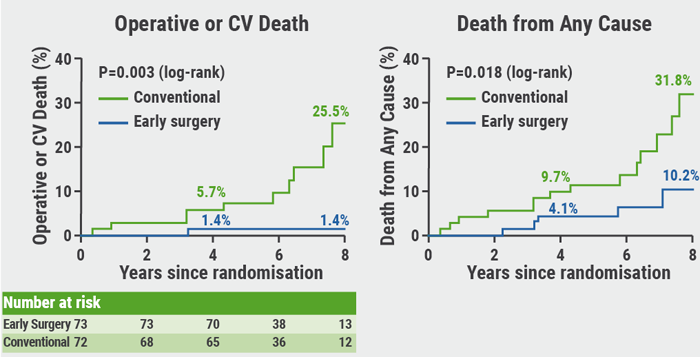The study intended to determine the optimal timing of anticoagulation initiation after atrial fibrillation (AF)-induced acute ischaemic stroke (AIS), which is associated with larger infarct volumes. Previous landmark randomised trials have all waited weeks or months to begin anticoagulation after a stroke, but this trial aimed to establish the clinical value of early intervention. To that end, the safety and efficacy of early anticoagulation were evaluated based on stroke size, secondary prevention of ischaemic stroke, and risks of subsequent haemorrhagic transformation.
Patients were randomised 1:1 to receive early apixaban (n=41) at day 0–3 for transient ischaemic attack (TIA), day 3–5 for small-sized AIS (<1.5 cm), and day 7–9 for medium-sized AIS (≥1.5 cm but less than a full cortical territory), or warfarin (n=47) at 1 week post-TIA or 2 weeks after a small or medium stroke (Figure). Patients with large AIS were excluded. Enrolment was suspended prematurely after a 2019 guideline update recommended direct oral anticoagulants over warfarin in AF, excepting valvular disease.
Figure: Study schedule for the AREST study (V1 = visit 1, time 0; EOS = end of study, day 180) [2]

Reprinted from Rose DZ, et al. Front Neurol. 2019;10:975. Copyright © 2019 Rose, Meriwether, Fradley, Renati, Martin, Kasprowicz, Patel, Mokin, Murtagh, Kip, Bozeman, McTigue, Hilker, Kirby, Wick, Tran, Burgin and Labovitz.
The primary study outcome was a composite of recurrent ischaemic stroke, TIA, or fatal stroke. Key secondary outcomes were intracranial haemorrhage, haemorrhagic transformation of ischaemic stroke, cerebral microbleeds, neurologic disability (e.g. modified Rankin Scores [mRS], National Institutes of Health Stroke Scale [NIHSS], Stroke Specific Quality of Life scale [SS-QOL]), and cardiac biomarkers (e.g. AF burden, transthoracic echo/transoesophageal echo abnormalities).
At 180 days of follow up, although not statistically significant, early intervention with apixaban resulted in empirically fewer recurrent ischaemic strokes, TIAs, or fatal strokes (19.5% vs 27.7%; P=0.46). Early apixaban use was not associated with increased risk of intracranial bleeding or any of the other secondary outcomes. Dr Labovitz concluded that the early use of apixaban is safe in this patient population and may potentially be associated with improved outcomes, although further studies are warranted.
- Labovitz AJ, et al. Apixaban for early prevention of recurrent embolic stroke and hemorrhagic transformation in patients with atrial fibrillation: results of the AREST trial. FS.AOS.04, AHA Scientific Sessions 2019, 14-18 November, Philadelphia, USA.
- Rose DZ, et al. Protocol for AREST: Apixaban for Early Prevention of Recurrent Embolic Stroke and Hemorrhagic Transformation—A Randomized Controlled Trial of Early Anticoagulation After Acute Ischemic Stroke in Atrial Fibrillation. Front Neurol. 2019;10:975.
Posted on
Previous Article
« New RNAi therapies to reduce triglycerides: 2 studies show favourable results Next Article
Immediate coronary angiography after cardiac arrest does not improve survival »
« New RNAi therapies to reduce triglycerides: 2 studies show favourable results Next Article
Immediate coronary angiography after cardiac arrest does not improve survival »
Table of Contents: AHA 2019
Featured articles
New Approaches to CVD Risk Reduction
Phase 3 BETonMACE trial did not meet its primary endpoint
Inclisiran safely halves LDL-Cholesterol
Colchicine prevents cardiovascular events
Interventional Management for Acute Coronary Syndrome
Drop aspirin after 3 months in non-STEMI ACS patients on dual antiplatelet therapy
Immediate coronary angiography after cardiac arrest does not improve survival
Complete revascularisation for obstructive non-culprit lesions with vulnerable plaque
Colchicine: no difference in peri-procedural cardiovascular events 30 days post-PCI
Intra-aortic balloon pump better than Impella: new observational data
Results for the Ischemia Trials: To Intervene or Not to Intervene
ISCHEMIA trial: Invasive treatment only better for angina burden
Controversies in Contemporary Management of Aortic Stenosis
Full GALILEO results: Why did rivaroxaban fail after TAVR?
Balloon-expandable better than self-expanding transcatheter heart valves
RECOVERY: Benefit of early surgery in asymptomatic severe aortic stenosis
Guidelines: Updates and Controversies
New guidelines on the prevention of cardiovascular conditions
Trials in Electrophysiology and Left Ventricular Function
RENAL-AF trial: Apixaban similar to warfarin
Apple Heart Study: Not just for atrial fibrillation
Early apixaban safe as secondary prevention of stroke from AF
Carvedilol does not improve exercise performance in Fontan patients
New Frontiers in Lipid Therapy
Icosapent ethyl plus statins reduces total plaque volume
ORION-9: Inclisiran RNAi halves LDL in familial hypercholesterolaemia patients
New RNAi therapies to reduce triglycerides: 2 studies show favourable results
Targeting LDL-C <70 mg/dL is better than 100 mg/dL after stroke
Challenges in Heart Failure Management
FUEL trial: Udenafil improves some exercise measurements in Fontan
DAPA-HF: Dapagliflozin also good for heart failure patients without diabetes, of any age, or any health status
PARAGON-HF: Benefits for women and lower ejection fraction
Related Articles

February 26, 2020
Carvedilol does not improve exercise performance in Fontan patients

February 26, 2020
Editor Biography
© 2024 Medicom Medical Publishers. All rights reserved. Terms and Conditions | Privacy Policy
HEAD OFFICE
Laarderhoogtweg 25
1101 EB Amsterdam
The Netherlands
T: +31 85 4012 560
E: publishers@medicom-publishers.com

